| THE ING NEWSLETTER | No. 2, March 2000 |
|
|
SCIENCE |
|
|
|
| Previous: | New Instrumentation for the WHT | Up: | Table of Contents | Next: | Y2K at the ING |
Other available formats: PDF | gzipped Postscript
The New WHT Mosaic Camera
Simon Tulloch
(ING)
Work on this camera started at
the RGO in Cambridge shortly before its closure and was continued at the
ATC in Edinburgh and subsequently ING. The design incorporates two EEV42-80
CCDs mounted in a standard 2.5 l Oxford Instruments cryostat normally used
for single chip cameras. This camera therefore has the same mechanical
interface to the telescope and could in principle be used at any port where
a single chip camera is normally used. In practice it will be dedicated
for use at Prime Focus (PF) and at UES on the WHT.
|
|
|
| Gain:
2.2 e–/adu for chip #1 2.0 e–/adu for chip #2 Quantum efficiency
|
Pixel scale:
0.24"/pixel
Field of view: 16.4' × 16.4' Pixel size: 13.5 µm square Image size: 4096 × 4100 pixels Readout time: 54 s Readout noise: 6 e– rms |
At prime focus this camera will double the field of view of the telescope with no vignetting from either the existing filter wheel or corrector. At UES the benefits will be from the EEVs smaller pixels (0.20"/pixel) and better blue response compared to the existing SITe detector. The EEV mosaic is marginally bigger than the SITe but since the UES output is already heavily vignetted in the outlying areas of the image, this will offer no advantage.
The camera performed well during its first science run at PF at the end of September 1999 and obtained the images that accompany this article. Some problems due to stray light were highlighted during this run and are currently being solved by the addition of extra baffling around the PF filter wheel. Some images obtained close to the celestial equator seemed to suffer some degradation due to a number of horizontal streaks extending across the full width of the images. These were later identified as geostationary satellites! Final commissioning at UES will start in late January 2000.
The CCDs were mounted on an invar baseplate that was ground flat to ±5µm accuracy. Subsequent measurement of the CCD surfaces, using an instrument developed at the RGO, showed that all pixels lay within 20µm of an optimal plane. The slight defocus that this will introduce into the small regions of the image furthest from the optimal plane, does not exceed 0.1 pixels. The physical gap between the CCDs was minimised by the use of PTFE shims. These allowed the devices to be close butted without actually touching. Once the chips were firmly screwed down to the base plate the shims were removed. The gap between adjacent image areas is only 39 pixels: approximately 1% of the total image width.
The camera was designed and built by Simon Tulloch. Dave Gellatly at the RGO was responsible for some initial mechanical design work and the ATC Mechanical Workshop was responsible for the machining.
The camera is now available as
a common user instrument at Prime Focus and at UES on the WHT.
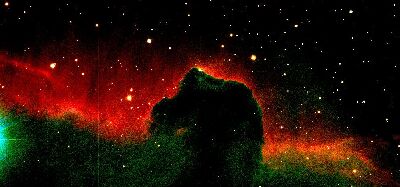 |
3 | 1 | 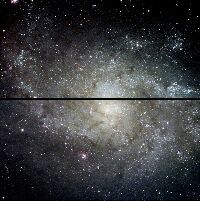 |
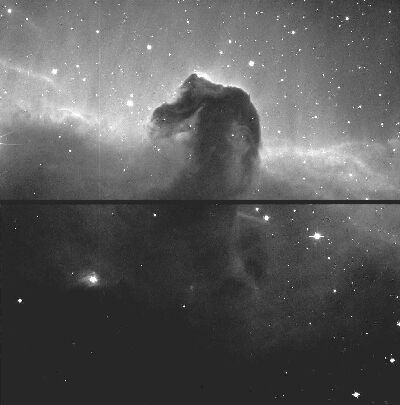 |
2 | (All
the images are credit to Simon Tulloch and Nik Szymanek)
Figure 1. BVR image of M33 Galaxy using the new 2-detector WHT prime focus camera. Exposure time was 10s. [ JPEG | TIFF ] Figure 2. 10s exposure of the Horse Head nebula with the new prime focus camera on the WHT. [ JPEG | TIFF ] Figure 3. Again as before but now combining B, V, and R images. Only one detector is shown. [ JPEG | TIFF ] Figure 4. The star-formation region M42, also known as the Orion nebula. Shown here is a 10s exposure true-colour image on the new WHT prime focus camera. The gas and dust in the nebula emits light because it is irradiated by nearby emerging stars. [ JPEG | TIFF ] Figure 5. The new WHT prime focus camera contains two EEV-42-80 thinned CCDs butted along their long axes to provide a 4K x 4K pixel mosaic. Each pixel is 13.5µm square. A single detector comprises 2148 x 4128 pixels in total including 50 x-underscan, 50 x-overscan and 28 y-overscan pixels. The active area of the mosaic measures 55.8 x 55.35 mm, with a 0.53 mm gap between the chips. Both chips have two working amplifiers giving 3–4 electrons noise. [ JPEG | TIFF ] |
|
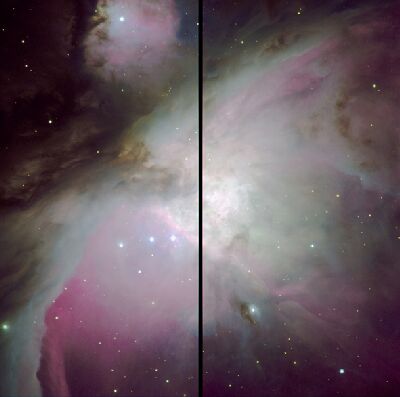 |
4 | 5 | 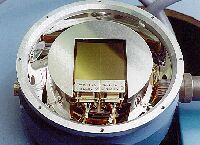 |
Email contact: Simon Tulloch (smt@ing.iac.es)
| Previous: | New Instrumentation for the WHT | Up: | Table of Contents | Next: | Y2K at the ING |
| GENERAL | SCIENCE | TELESCOPES AND INSTRUMENTATION | OTHER NEWS FROM ING | TELESCOPE TIME |